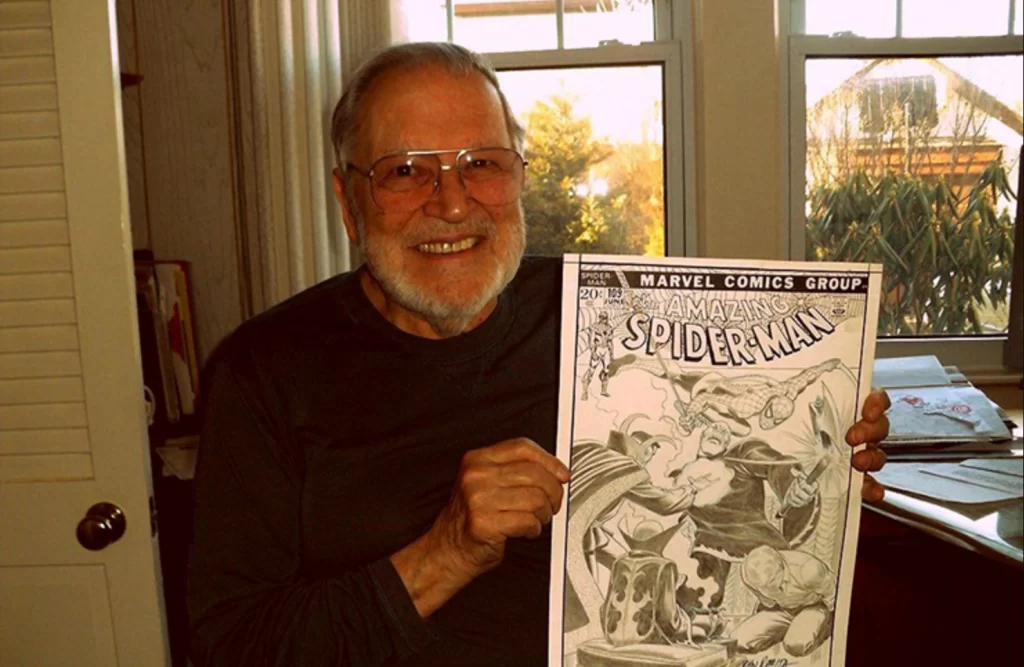That sound you hear among genuine comic book fans is the deafening silence in response to the news about Marvel Comics’ legendary penciler, John Romita Sr., who has died.
The comic world has lost one of its true stalwarts. His son confirmed Romita’s death via Twitter.
A son of Brooklyn during the fragility of the Great Depression, John Romita Sr. would find art to be a catharsis growing up. Eventually, it became a passion that led him to the School of Art and Design in Manhattan. What surprises some fans is that his first job was not at Marvel Comics; he worked for DC during his first eight years in the industry.
“Jazzy,” as he would later be dubbed, found his home at Marvel Comics. While manning an art desk in Stan Lee’s utopia, John Romita Sr. would become galvanized with the art of seminal characters, such as Black Widow, Luke Cage, Kingpin, The Punisher, and Wolverine.
However, his most indelible impression in the hearts and minds of comic book fans worldwide was as the pencil behind the Friendly Neighborhood Spider-Man. In a gripping tribute to their legendary artist, Marvel wrote:
Millions came to know Marvel through his art, and millions more came to know Peter Parker through the unmistakable bold brushwork Romita brought to his pages. The Marvel family has lost one of its legends, and we mourn the loss of a creative giant. Our hearts are with his family and loved ones as we remember his legacy.
John Romita Sr. and His Legacy

There are certain names in the comic book industry that are “must-knows” among like-minded enthusiasts. Those are the Mount Rushmore names like Stan Lee, Jim Lee, Jack Kirby, Steve Ditko, Will Eisner, Neal Adams, and John Romita Sr.
Somehow, a Jazzy rendition of any superhero always stood out in a crowded bookshelf. As one of the true greats in the business, John Romita Sr. understood the mythos of his characters, which always resonated in his artwork.
Like, look at Spidey up there. Peter Parker was a boy in a criminalistic man’s world. He loved to fight the bad guys, almost as much as he adored some R&R. Many artists didn’t stop to think about their characters beyond the words on a page. Romita looked past the pages and into the character’s soul because without that vantage point, no one would care about the art.
Some are artists. Others are storytellers. That was the epiphany John Romita Sr. discovered at Marvel.

Ever heard “less is more?” John Romita Sr. understood that at an early age, which is why his artwork stands out to this day. Among the comic book faithful, Jazzy’s hand of skill and precision was overwhelming. That is only equal as his remarkable restraint. Many artists go overboard on shading, depth, gravitas–not him. One of his greatest gifts, it seemed, was Romita knew when he was done and put his pencil down.
It has been said another bewildering effect he had on comics was a romanticism with the art. His attention to detail was second-to-none. Look at the Spider-Man comics from the late 1960s into the 1970s. Notice the nuance he placed on Mary Jane’s wardrobe, hair, or facial expressions. That’s a pro wokring those lines and everyone knew they belonged to the master artsman, John Romita Sr.
To say “He’ll be missed” is an understatement because with his passing goes his story and commitment to the artwork. Few people have ever been able to do what he did because of how and why he did it. And for that, we all owe him an enormous debt of gratitude for being a much larger nerd than all of us. He was one of only a few people to be inducted into the Eisner Awards Hall of Fame and the Inkwell Awards Hall of Fame. He was a true titan among the giants and his shadow will always loom greatly.
John Romita Sr. was 93 years old.
Since he saw ‘Dune’ in the $1 movie theater as a kid, this guy has been a lover of geek culture. It wasn’t until he became a professional copywriter, ghostwriter, and speechwriter that he began to write about it (a lot).
From the gravitas of the Sith, the genius of Tolkien and C.S. Lewis, or the gluttony of today’s comic fan, SPW digs intelligent debate about entertainment. He’s also addicted to listicles, storytelling, useless trivia, and the Oxford comma. And, he prefers his puns intended.





![‘Frankenstein’ Review – Guillermo del Toro’s Definitive Look At The Nature And Nurture Of Monstrosity [TIFF 2025] ‘Frankenstein’ Review – Guillermo del Toro’s Definitive Look At The Nature And Nurture Of Monstrosity [TIFF 2025]](https://cdn.geekvibesnation.com/wp-media-folder-geek-vibes-nation/wp-content/uploads/2025/10/Frankenstein-175_PF_20240430_20377_R-300x200.jpg)
![‘Wake Up Dead Man: A Knives Out Mystery’ Review – In Rian Johnson We Trust [LFF 2025] ‘Wake Up Dead Man: A Knives Out Mystery’ Review – In Rian Johnson We Trust [LFF 2025]](https://cdn.geekvibesnation.com/wp-media-folder-geek-vibes-nation/wp-content/uploads/2025/10/Wake-Up-Dead-Man-A-Knives-Out-Mystery-300x169.jpg)